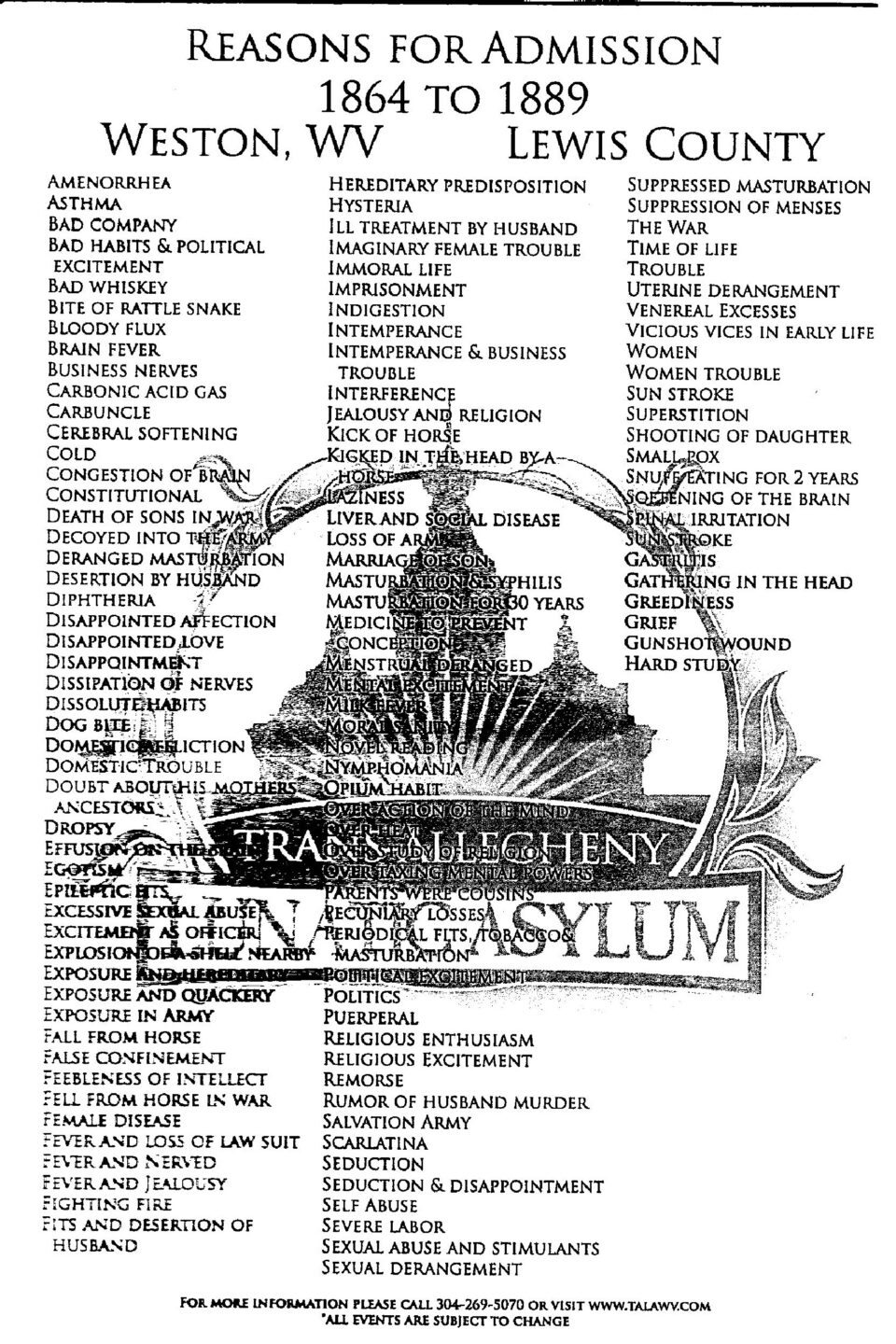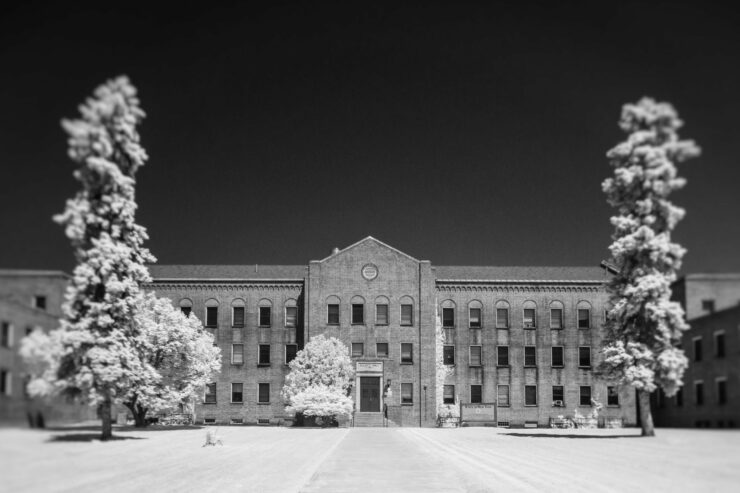First off, let me say, this is the most difficult story I have worked on to date. Asylums are notoriously difficult to write about due to their sordid and often clouded histories. Truth is, most asylums are closed due to atrocities of some nature. And because of those horrors and in the best interest of the patients, details of these asylums are off-limits. The asylum I write about today I feel, was a victim of its mantra. Willard State Hospital believed that insanity was not just some blanket diagnosis for anything we didn’t fully understand. To mistreat and lock these people up was not the answer. Through common sense they could not only help these people, they rewrite the books on what we consider insanity today. Take a look at this document provided by my good friend and equally good photographer Amy McGovern. I highly suggest you check out her Flickr page (here)

As you can see there was very little we DID understand back then. Willard, I believe, made an effort to change that.
A Minor History
Willard Drug Treatment Center today is a specialized state prison in Seneca County, New York, USA. The prison focuses on treatment of drug-addicted convicts. Willard Drug Treatment Center is located in Willard, a community in the Town of Romulus, and is adjacent to Seneca Lake in the Finger Lakes District. Willard is a 900-bed intensive “boot-camp” or “shock-camp” style drug treatment center for men and women. Today it is only mere shadow compared to what it once was. And while it’s mission path may be a different one, its goal of rehabilitation is still the same.
In The Beginning
The asylum, located on the shores of Seneca lake in upstate, NY was once a sprawling community for the feeble and at the time, considered “insane”. Willard was no traditional asylum. During the late 1800’s was not uncommon to keep those deemed as insane naked, bound in chains and locked up 24-7. When Willard Asylum opened it’s doors to patients in October of 1869 it had a different idea on the care of the insane. It believed that if you give a person freedom and purpose along with a beautiful environment that it will help them towards rehabilitation. The terms for insanity were much different in those days.
Patient Number One, and the Proof:
It was said that Mary Rote arrived by steamboat at the Ovid landing on Seneca lake and was the first to arrive at the then new asylum. Dr. Hoyt, Secretary of the Board of State Charities, claimed she was deformed and demented and chained at the wrists. She was being moved from the Columbia County Poorhouse where she was found bound, naked, and crouched in a corner of a 5ft cell without any covering or even a bed. In fact, she was confined this way for over 10 years. Mary died at Willard in January of 1876 of tuberculosis, but by that times she had become a role model for patients in years to come. Mary’s doctor at Willard, Dr. Chaplin states, “Since her admission, she had been daily dressed and at all times presentable. Her general appearance and habits of cleanliness are much improved.” This is not the only story of success at Willard. There were many that followed. It is clear to me that Willard may have been responsible for a pivotal change in how we look at and treat mental health in the United States. And now more than ever, at a time where I think most of us feel that mental health needs more attention than ever, it is important to look back and see how we made changes that helped many, many people live out more fulfilling lives. People, who would have otherwise died in these “asylums”, alone, naked, and nameless.
The Adventure
Once a year, every year the Elizabeth Cady Stanton Children’s Center holds an open house and allows people to tour the grounds at Willard. Unfortunately, I was not granted access to the REAL Willard buildings. During the sign-up on site I was told by at least ten people what I could and could not shoot. Even though I explained to the folks there that I was not interested in having any people in my shots, they proceeded to remind me every time I set up the tripod that I could not film anyone in a green or orange uniform (Willard DTC resident). I totally understood the worry, but I make an extreme effort to present myself in a professional manner and this constant badgering was getting annoying. Apparently, in the past it has been an issue for them so I tried not to let it bother me too much. All of the nice folks that run the tours are daycare center staff, board members, and former employees of the psych center that graciously donate their time and efforts. All proceeds from the event goes to the center and the children served here. I talked with several and inquired about gaining access to some of the buildings that were not on the tour. Looking for more decay than anything. I did get several names and contacts as well as comments that it shouldn’t be a problem at all. At all of these types of shoots I always offer to donate proceeds from print sales and offer to allow the Historic society to use the photos for their websites and installations. With all of that said, a day after the first shoot I attempted to contact both by email and by phone the names I was given. With several attempts since I still have had no return contact. This has been very disappointing to me. So much so, I consider not releasing this story and shoot. I rarely like to put anything out that is not complete and I feel there was much more there that needs to be recorded.
Willard is an hour from my home so I was out the door around 7am and on the road. When you arrive you stop at the Historical Society building out on the main street and they direct you to another building for sign-up. You are assigned a group and wait until your number is called and then head off to the first destination which is the Willard Firehouse. The firehouse is still in operation today and serves the DTC and surrounding areas. Here is their prized 70’s era Ford fire truck.
While setting up the fire truck shot I got to talking with one of the gentlemen working there about what I do and after a few minutes he says, “let me take you somewhere off tour, follow me”. He led us to the “power plant” for the facility. I absolutely love industrial stuff. Usually it’s more of the decay stuff I go for but this was cool.
This stuff was great, but still not the real content I was looking for. Next stop is Hadley Hall, and from the looks of the outside, this would be more of the same.
I am excited to get inside as I had heard this was an old movie theater. Upon entering the hall with the group though, a sinking feeling starts to set in.
Maybe Willard does not need my help. There has only been one building on campus that was in ruins and they would not let me anywhere near it. So far, everything here looks restored and re-purposed already. I have heard stories though, and seen some photos. There must be more than meets the eye. Again, I begin conversing with the volunteers milling about and another gentleman comes to the rescue. He tells me that he knows of what I am looking for and leads me to the basement. Low and behold, through the dark there is a complete exercise room and beyond that, it’s literally game on!
Aside for the sagging ceiling overhead, these lanes are just beckoning to be used again. I had all I could do not to grab a ball and roll a few. It doesn’t look as though it would take much to get this place rolling again.
This next shot is one of my favorites from the day. I was having trouble coming up with a name for this but a fans from my facebook page came through for me! All the names were crazy good and really tough to choose from. One name really stuck out to me and that was “Memory Lane”. Congrats goes out to Todd S. who came up with the name and wins a free print of the shot. Thanks Todd, and everyone who participated.
A tight squeeze gets me behind the pin setters, and it looks like someone has had some fun back here with a full rack set up and ready to go.
Funny thing about the bowling alley, all the pins, balls, even score sheets where still left there yet, only one pair of shoes could be found anywhere, curious.
It was along about this time the tour group started milling about so my shooting down here is done. I headed back up stairs and the same gentleman that helped me with the alley stopped me again and told me he had one more surprise for me and led me up a set of stairs that was roped off to the public. While 90% of the original theater was removed from the first floor, upstairs I found a full complement of the original theater seating in place.
And around the corner at the top of the balcony was the treasure chest. A fully complete projector room including a pair of Brenkert/RCA carbon arc projectors.
It was a real treat to find these fulling in tact. Most, to make them more efficient, and safer are converted to xenon lamps. The carbon arc projector used high voltage arcs across two 1/4″ diameter carbon rods. This is supplied by a large AC/DC rectifier called a “Rect-O-Lite”. These boxes converted 230 volts of phase 3 AC to 24-36 volts of DC at massive 45 amperes!
The resulting “spark” is the light used to project the movie on the screen. These massive machines are loud, hot, and extremely dangerous. On top of that, much maintenance is needed to keep them in operation. Along with the projectors the films themselves need slicing and repair from time to time. Everything needed to get the job done is here in the booth.
One of the most fascinating things about the booth is that over the years, the on-duty projectionist would write the date and the movie neatly on the walls of the booth. The entire booth is covered in these listings.
One film is shown more than any others, “Howard”. I was told that this was a film about a state hospital patient that recovered and was shown as an inspirational film for patients. I could not confirm this as I could not track down a definitive description of the film. Note the hundreds of listings on the walls in this shot. (Editors Note/Update) One of the things I LOVE about doing this job is meeting the people who my stories and photos reach, and have a connection of some sorts with a site. Today, almost a year after I released this story, I was contacted by Leatha Smith-Fo, who finally solved the “Howard” mystery. The reason I could find no reference to the movie, is because it was no movie at all. Howard is Leatha’s father! He was the projectionist at Hadley Hall and showed movies there on Saturdays. Leatha has a history with Willard too. She grew up in town and knew many of the patients and has seen all of the buildings there. Both of her parents worked there and are since retired. Sadly, Leatha’s father passed away in 2007. Here is an awesome photo she sent along of her dad in the booth! Leatha, Thank you so much for reaching out.

What a great treasure chest the projector room turned out to be. Time was limited today as it always is so the next stop on the tour was a building called Eliott Hall.
Elliot Hall as you can see was built in 1931 as the campus Hospital. With this being such an ominous building, I expected it to be full of cool scenes to shoot.
I made my walk down the block long entrance only to find this guy guarding the door. Quite startling!
Unfortunately for me, this building is used to train NY State Corrections Guards. The entire hospital has been turned into sleeping quarters and classrooms, which for the use of the property is great. I stayed long enough to get the background photo you see on this page as well as the header photo with the Willard State Hospital logo at the top the article. While there I was told that I needed to see, dun, dun, dunnnnnn, the morgue. So, off I went, skipping, er, driving to the morgue. I seriously did not know what to expect here. From the outside, it looks like any of the other buildings. Inside however, was a wonderful surprise.
The inside of the morgue was left pretty much the way it was when it was closed in 1995. Obviously time has left its mark here. The guide there was actually an autopsy assistant and was full of great information about the various items left behind. The “fridge” storage was notoriously problematic. Quite often the custodian there would have to work on the compressor which was located in the back. The only way to get to the back was to climb through the #2 body tray. I hope they paid him well. Ironically, the Gotham temperature gauge on the box was still functioning perfectly.
This cavity scoop was one of the more morbid tools left behind. I wonder why no one wanted that?
Formaldehyde bottles and various chemical containers still occupy the shelves.
Of course the centerpiece to the scene was the autopsy table. I think the fact that it was so clean everywhere else and so dirty in here made it all that much more creepy.
Running out of time and steam quickly we decide to make the cemetery at Willard our last stop, but on the way our explorer side gets the best of us. Over a barricade and small fence lay the ruins of the old dock known as Willard Landing.
A pretty good-sized storage building stood here once where patients were regularly received by steamboat. Now, nothing but old concrete foundations reaching out into the lake.
Just to the north of the old landing dock was a single solitary bench just beckoning for a soul to come sit and ponder life while gazing over the glass still lake of Seneca.
On the way out that day I stopped to take one more un-authorized photo. This unknown building on the campus was not open for the tour.
This would put an end to my long day it was time to head home. It would be several months before I would reluctantly return to Willard. The lack of response over my shoot and even a return phone call or email to tell me that it was not possible shoot the other buildings must have been too much of a task for anyone to bear. I understand that the Historical Societies hands must be tied, but I went directly to the head of the DTC as instructed, with no response. Anyway, I was notified by a friend that the suitcase tour would be happening and decided to go at least see it and find out if there was any chance at getting entry. On display were several suitcases that belonged to Willard patients that were discovered some years back in an attic of one of the buildings. The suitcases were interesting, but the presentation was less than stellar with a pre-talk that lasted nearly 90 minutes, snooze.
The suitcases were all displayed on tables around the perimeter in Hadley hall and towards the end of the sermon, er speech, folks started getting bored and were meandering off to look at them. I had sat long enough in the 90+ degree heat and made my move. Unlike some, I will keep the dialog to a minimum here and let you enjoy the vintage.
This final suitcase warrants some discussion as it belonged to a photographer who was known only as Mr. Herman #20884. Here is his short story as taken from “The Lives They Left Behind”
Mr. Herman #20894 had his first seizure in 1902 at age 18, perhaps as the result of surgery he underwent at age four. Diagnosed with epilepsy, he was sent from his Brooklyn home to the new “Craig Colony” in rural upstate New York in 1908. The Colony was the State’s first attempt to understand and care for people with epilepsy. Photography was an important tool in that research and, within a few years, Herman was closely assisting the Colony’s photography staff. By 1915 he was working as a photographer in his own right, taking pictures of staff and his fellow patients, and was well-regarded for his skills. At the same time, he was described as a “model patient” and was largely free of seizures.
“No Place To Go”
By 1930, having spent most of his adult life institutionalized, Herman was described in his file as being depressed and uncommunicative. He was admitted to Willard, despite the examining physician’s statement that “no reason could be found for this patient being at a state institution for the insane.”
Herman stayed at Willard for 35 years, but never again worked as a photographer. He was one of many Willard patients transferred for several years to the Sampson Division, a short distance away, to help relieve overcrowding at the main facility. His records state again and again that he was indifferent and generally disinterested, though well-behaved and willing to help on the wards when asked. Apparently, he had no more seizures. When Mr. Herman was in his seventies, he was offered the opportunity to leave Willard: “Where would I go?” he answered. “No place to go.” He stayed there until he died in November 1965. His family had his body returned to Brooklyn, where he was buried in the Mount Olivet Cemetery. Written by Darby Penney and Peter Stastny, you can find more @ www.suitcaseexhibit.org
Mr. Herman carried his whole life in a box, this is that box.
Overall, this was not one of my favorite shoots, simply because it was cut so short and incomplete. Nevertheless, I still feel my images need to be seen and my story about Willard needs to be told. Someday, maybe someone will read this, see the images I have captured and invite me back two Willard to finish the job. One can only hope, just as those did all those many years ago, at the asylum by the lake.
Please consider visiting my galleries and purchasing a print to help fund my efforts. Thank you.





























































I grew up living in Willard across from the buildings. Most of my family worked there and my siblings and I have ventured in and out of a lot of these buildings. If you ever want more info; contact me. My parents still live in the house I grew up in and could tell you many stories while working there.
I find this interesting and I had an Aunt that worked there years ago.Id like to see more pics and hear more stories
My husband was in Willard in the 70’s and I would love to speak with someone who worked at Willard during that time frame…do you know anyone?
thank you,
Bonnie Morris
Would love to hear your stories
Hi, We just visited the area. Stayed across the street. Amazing place. I would love to know more. Please contact me. Bob
I worked at the Willard Psychiatric Center from 1968-1995 and at the Willard DTC from 1995-2005. My husband grew up in Willard and has many fond memories of the PsychiatricCenter Center, as do I. Would love to talk to you.
Hi Lynda, feel free to use my messaging form on the Who is AD menu.. I always respond to my emails. 🙂
Both my parents worked there My dad was in the safety department. I have a picture of all the trucks and crew in front of the firehouse.
All of my immediate family worked there. I worked there from 1955 until about 1978 from being a farm worker to a safety officer. I began my career in public safety at the Willard fire house and spent 47 years in two states in that profession.
I am from the Finger Lakes and have always heard stories but have always wanted to know the history. Thank you I think I will read more
I worked in Sunnycroft from ’68 till ’77. Can anyone tell me the name of the buildings down near the lake? I can’t remember. I think there were two.
South Home? Was a student nurse residence that I lived in.
No, that’s not it. The one I’m thinking of housed residents. Maybe it was the Pines. I just came across that name in a long history of Willard. http://www.asylumprojects.org/Willard.pdf
The house or building nearest to the lake is The Pines.
The building by the lake were Pines and Edgmere
Now it’s coming back to me! Your name sounds familiar, too. Where did you work?
I worked in South Wing, Elliott Hall, Birches, Grounds Supervisor 3-11 and 11-7. Elliott Hall in operating room.
Pines and Edgemere
That’s the ones. Thanks!
Pines Building and Edgmere buildings are down by the lake.
Yes, during our last visit there I was denied accessed.
These are all familiar to me . I worked there for 31 yrs. My husband worked there for 20 yrs and took care of the refrigeration for the morgue as will as the whole hospital.
I also went to Nursing School there and lived in South Home. Many fond memories of those patients.
Have you ever thought about throwing in some tilt shift? I bet it would make for some wild creepy images.
My parents were both patients there and I did my college internship at willard shock camp in 2005. I find the whole willard asylum very intriguing. Both parents suffer from acute mental illness. I went there as a child for visits with my mom. Off willards grounds. Would love to hear more about the way it was
Thank you for sharing your story Rachael.
I would also like more of the history of Willard because my grandmother was a patient, roughly 1915 thru 1955. We don’t even have a photo of her, tho I learned they later took file photos of patients. Some years ago I tried to find my grandmother’s file and photo only to learn it had been destroyed in the 1970s. I also have a bundle of letters from a doctor to my mother explaining why nothing had changed for her there–form letters, when my mom needed some personal interaction or a photo. When the suitcase exhibit was in Albany, I traveled from Oregon to see & maybe discover if it shed some light on my grandmother, but discovered nothing, only saw some embroidered items and wondered if my grandmother had done any as that was her specialty. No recognition of who had done thebwork. Many of us who had relatives there need to see a commemorative book!
Can somebody tell me all about willard drug and rehab in this present time of 2018
Not sure what you are asking. I wrote this article in 2013. Nothing there has changed other than the Morgue being demo’d.
Found your work researching shock therapy…too bad they are not more transparent…
I went to the open house a few years back. It was complete chaos. There were hundreds of people. I was very disappointed as I actually walked all the way to the back and paid our fees for the tour. Many many others did not. Of course they may not have known where to go. We quickly got losses from our tour guide. Therefore did not get any of the stories. I did get a few interesting photos though. The one thing I did not get to see that I would have liked to is the cemetery. Is this private? Or can the public visit there? Thanks for sharing the stories. I love your photos.
Because Willard is still partially an active campus the public is only allowed during open house. You may be able to contact the local Historical society for a private tour but I doubt it. My shots were all from 2 public tour open houses. I have since been invited back for a private shoot but have been unable to make time for it.
My parents went to work there in the depression and being singles, they had to live on the grounds. That was before the strong drugs were used and he said it was not unheard of to have an employee killed by an patient. Mom was a widow with an infant and was required to have my half-sister taken care of by a relative off campus. All of us kids roamed the hospital grounds and went to the movies on Saturdays. We sat in the balacony seats and often went to the soda bar in the basement for goodies. Dad worked as a safety office/fireman in the firehouse and mom was a housekeeper across the street. They had a pool table upstairs and a fire pole we could slide down! We used to swim and frolic at the lake where the old cannery was. You could swim under the dock….dark and scary! As we roamed the grounds, we ever felt threatened and patients were all over. They had cattle on the east end of the grounds and there were wonderful barns to explore.
My parents owned a grocery store called the J&R Superette. We grew up in this community and knew many of the patients who would frequently come to the store to buy cigarettes or items they wanted. As kids, we would go to the movies at Hadley Hall on Saturdays in the balcony and sometimes we even attended the church services on Sunday morning. We had plenty of interaction with employees as well as patients throughout the time we grew up and had the store in Willard. I even have an original painting from Dr. Luisa Kerschbaumer who worked at the psychiatric center and was an artist. The psychiatric center also provided a place for us to golf at The Bonavista State golf course and ice skating as well as softball games that happened on the ball diamond. The psychiatric center was an employer for many in the community. We all grew up with the facility and observed how mental health changed and how patients were treated and rehabilitated. One of my valued artifacts is a book that was published and given out that has a complete history and photographs of the grounds from conception to finished facility. I’m glad to see someone has captured otos and published the artifacts of the historical aspects of Willard Psychiatric center.
I was an occupation therapy student during the summer of 1991. Beautiful campus and enjoyed all of my patients.
Thank you for stopping by Erica!
As the Superintendent of Willard DTC from 2000-2009 it was my pleasure to meet and come to know many fine people who had worked at the Psych Center. All of them had great memories of working there. In adition, many came to work at Willard DTC when the change over was made in 1995 which was a great help. It was unfortunate that so many buildings were abandoned but many were restored due to the Department of Corrections taking over the abandoned facility. Truly there is a great history here. You may find some of the answers that you are looking for from the Historical Society which has a building right on the grounds.
Thanks for stopping by and commenting. I have had great luck dealing with the folks at the Historical Society. Would love to photograph more of the closed buildings at this point. Hopefully there is an opportunity to do so in the near future.